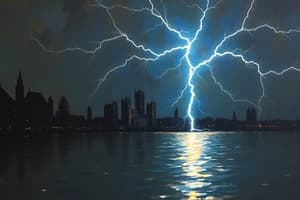Podcast
Questions and Answers
What is the SI unit of electric charge?
What is the SI unit of electric charge?
- Coulomb (correct)
- Volt
- Ampere
- Newton
Which of the following statements about electric charges is true?
Which of the following statements about electric charges is true?
- Opposite charges repel each other.
- Charges are always conserved. (correct)
- Electric charge is a vector quantity.
- Like charges attract each other.
What quantity does an electric dipole moment (p) depend on?
What quantity does an electric dipole moment (p) depend on?
- The angular momentum of the dipole.
- The total charge and its velocity.
- The charge density within the dipole.
- The magnitude of one charge and the separation distance. (correct)
In which situation does a stationary charge produce a field?
In which situation does a stationary charge produce a field?
What is the electric field due to a point charge at a distance r from it?
What is the electric field due to a point charge at a distance r from it?
Which of the following correctly describes electric field lines?
Which of the following correctly describes electric field lines?
How does the electric field due to a dipole at an axial point compare to that at an equatorial point?
How does the electric field due to a dipole at an axial point compare to that at an equatorial point?
What kind of field is produced by a moving electric charge?
What kind of field is produced by a moving electric charge?
Flashcards are hidden until you start studying
Study Notes
Electric Charge
- Electric charge is a fundamental property of matter.
- There are two types of electric charges: positive and negative.
- Like charges repel each other, and opposite charges attract each other.
- The SI unit of electric charge is the Coulomb (C).
- 1 Coulomb is equivalent to 3 x 109 electrostatic units (esu) or 1/3 x 10-9 electromagnetic units (emu).
- Electric charge is a scalar quantity.
- Charge is quantized, meaning it exists in discrete units. The charge of an object can be expressed as q = Ne where N is an integer ( ±1, ±2, ±3...) and e is the elementary charge (approximately 1.602 x 10-19 C).
- The amount of charge on an object is constant regardless of its velocity.
- A stationary charge generates only an electric field.
- A moving charge creates both electric and magnetic fields.
- Electric charge is conserved, meaning it cannot be created or destroyed, only transferred.
- Coulomb's law describes the force between point charges. It only applies to point charges, which are idealized charges concentrated at a single point in space.
Electric Field
- An electric field is a region surrounding an electric charge where another test charge would experience a force.
- Electric field is defined as the force per unit charge.
- It is a vector quantity, meaning it has both magnitude and direction.
- The SI unit for electric field is Newtons per Coulomb (N/C) or volts per meter (V/m).
- The electric field due to a point charge (q > 0) is given by the equation: E = (1/4πε0)(q/r2), where ε0 is the permittivity of free space and r is the distance from the charge.
- Electric field lines are imaginary lines that represent the direction of the electric field at a point. These lines originate from positive charges and terminate at negative charges, although they are not physical entities.
- Electric field lines are continuous and form closed loops.
Electric Dipole
- An electric dipole consists of two equal and opposite charges separated by a small distance.
- The electric dipole moment (p) is defined as p = q(2l) where q is the magnitude of one charge and 2l is the separation between them.
- Electric dipole moment is a vector quantity.
- The torque experienced by an electric dipole placed in a uniform electric field is given by τ = p × E.
- The electric field due to a dipole at an axial point (along the line connecting the two charges) is given by E = (1/4πε0)(2p/r3).
- The electric field due to a dipole at an equatorial point (perpendicular to the line connecting the two charges) is given by E = (1/4πε0)(p/r3).
- Important Note:* The provided text is fragmented and contains some missing parts. The above summary is based on the visible details and attempts to construct complete sentences and equations based on the context. Complete understanding would require the full, un-cropped image.
Studying That Suits You
Use AI to generate personalized quizzes and flashcards to suit your learning preferences.




